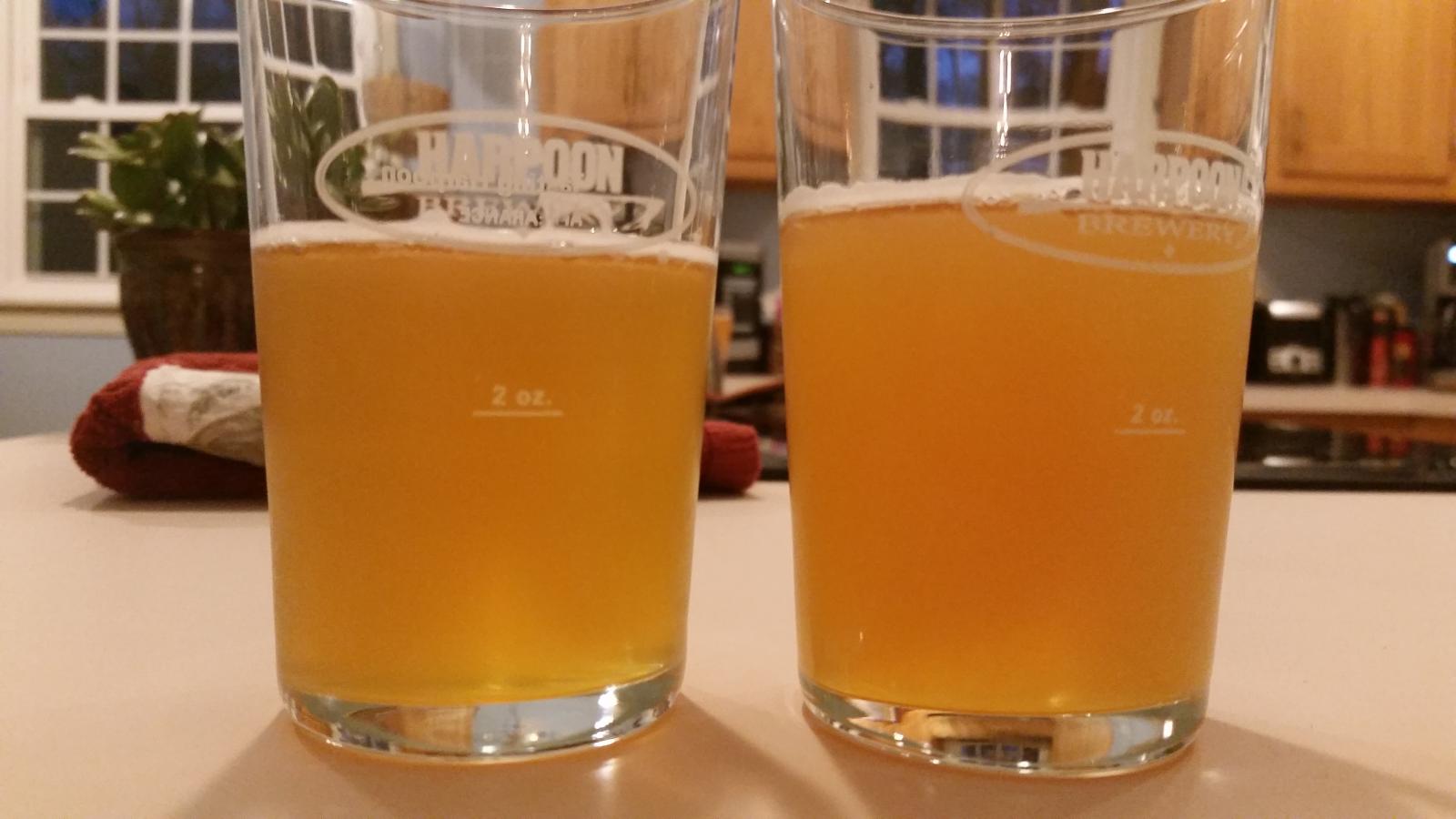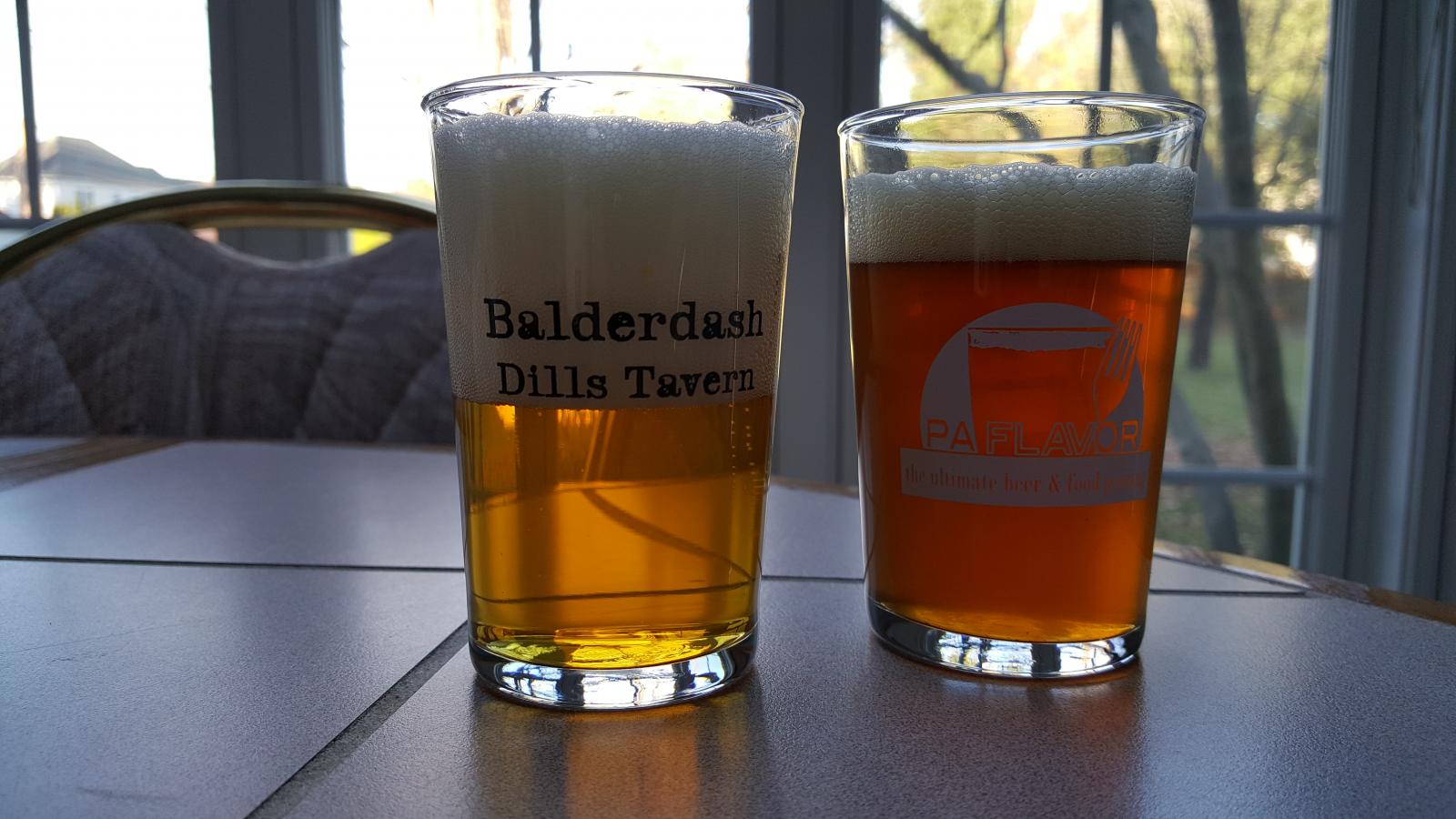user 141939
Well-Known Member
- Joined
- Dec 31, 2012
- Messages
- 642
- Reaction score
- 61
Also not too worried about a dry beer. I always actually struggle with over attenuation so getting a dry beer is easy for me[emoji4]

I changed the recipe somewhat before I brewed it to put most of the mid-boil bops into a flameout and then i did a hop-stand for around 20-30 minutes. It came out nicely, but not very much like Lunch.
I know some people have had good luck with flameouts w/ hopstands, but to be honest I always get a slight vegetal taste when I load up on flameout hops like that. I read else where that they bitter with magnum and then do equal amounts of centennial, simcoe, amarillo every 15 minutes.
If I was going to make this again (probably will but not right away), I'd go with the following:
Recipe Specifications
--------------------------
Boil Size: 7.50 gal
Post Boil Volume: 6.37 gal
Batch Size (fermenter): 5.50 gal
Bottling Volume: 5.25 gal
Estimated OG: 1.065 SG
Estimated Color: 8.0 SRM
Estimated IBU: 53.6 IBUs
Brewhouse Efficiency: 58.00 %
Est Mash Efficiency: 73.8 %
Boil Time: 60 Minutes
Ingredients:
------------
13 lbs Pale Malt, Maris Otter (3.0 SRM)
2 lbs Munich Malt - 10L (10.0 SRM)
8.0 oz Cara-Pils/Dextrine (2.0 SRM)
8.0 oz Caramel/Crystal Malt - 40L (40.0 SRM)
8.0 oz White Wheat Malt (2.4 SRM)
0.20 oz Warrior [16.00 %] - First Wort 60.0 min
0.50 oz Amarillo Gold [8.50 %] - Boil 30.0 min
0.50 oz Centennial [10.00 %] - Boil 30.0 min
0.50 oz Simcoe [13.00 %] - Boil 30.0 min
0.25 oz Amarillo Gold [8.50 %] - Boil 15.0 min
0.25 oz Amarillo Gold [8.50 %] - Boil 15.0 min
0.25 oz Centennial [10.00 %] - Boil 15.0 min
0.50 oz Amarillo Gold [8.50 %] - Steep/Whirlpool
0.50 oz Centennial [10.00 %] - Steep/Whirlpool
0.50 oz Simcoe [13.00 %] - Steep/Whirlpool
1.0 pkg London Ale Yeast (Wyeast Labs #1028)
1.50 oz Amarillo Gold [8.50 %] - Dry Hop 7.0 Days
1.50 oz Centennial [10.00 %] - Dry Hop 7.0 Days
1.50 oz Simcoe [13.00 %] - Dry Hop 7.0 Days
I emailed MBC about the yeast, and the reply I got back says they use wyeast 1056.
So take that for what it's worth.
Just throwing in my 2 cents....
I would look to tweak the hopping schedule and yeast. I would use a neutral yeast like 1056 or S05 or whatever then WL is (I think 001).
As far has hopping goes, I have found that lots of late additions makes the bang for your buck and best results. Usually I tend to FWH for almost my entire amount of desired IBU. In this case It would be warrior. Then at about 10 minutes I will do some additions to get my remainder IBUs but more so the flavors. Finally I usually add a huge chunk of hops (however you want to blend the flavors associated with those hops) as the wort is cooling. I shoot for a temp around 140 degrees. No real science here, heard it on a few pod casts and tried it and it worked for me. I don't end up with vegetal tastes and the flavor/aroma seems to last longer. Lastly I only dry hop for a few days.
I have also found, that a lot of craft breweries who list their ingredients list all teh things used over all the iterations. I don't know if all the hops listed on the web site are needed to get something close.
All in all, brew what tastes good to you whatever your process. Enjoy!!!
I wonder if they've adapted it to their brewery over successive generations. The attenuation that they report is much higher than 1056.
Going by the figures on their website, they're getting 91% attenuation, 1056 is a mid-high 70% attenuator. Either their website is incorrect, or their strain is much more voracious than the retail 1056.





![Craft A Brew - Safale S-04 Dry Yeast - Fermentis - English Ale Dry Yeast - For English and American Ales and Hard Apple Ciders - Ingredients for Home Brewing - Beer Making Supplies - [1 Pack]](https://m.media-amazon.com/images/I/41fVGNh6JfL._SL500_.jpg)






I'm going to try to rebrew this within the next couple of weeks. Their attenuation is pretty ridiculous, even with a low mash temp, unless you add corn sugar. I'm just going to use a more attenuative yeast (WLP090 Super San Diego) and mash low and just accept a higher FG.
Est OG: 1.061
Est FG: 1.008
ABV: 7%
IBU: 57
SRM: 6
81.5% Pale Malt
7.40% Munich Malt
3.70% Carapils
3.70% Caramel 40L
3.70% White Wheat Malt
1.0oz Magnum @ FWH
2.0oz Amarillo @ Flameout
2.0oz Centennial @ Flameout
2.0oz Simcoe @ Flameout
2.0oz Amarillo @ Dry Hop 4 Days
2.0oz Centennial @ Dry Hop 4 Days
2.0oz Simcoe @ Dry Hop 4 Days
1000ml starter of WLP090
Mash @ 148f for 60 minutes
I'll post my results -- probably be like two months or so.
I've been having great results recently with putting half of my flameout hops in at flameout. Then I start chilling and once the wort drops below 180f, I dump the rest of the flameout hops in and stir pretty vigorously. Then, I do a huge dry hop for a short period. I use a paint strainer bag when transferring to my bottling bucket to strain out all of the hop mass.
After carbing, they're a touch on the "vegetal" side for a few days, but usually by 3 weeks in the bottle that has aged out and you get a huge, "hop flavor" bomb with restrained bitterness.
I'm going to try to rebrew this within the next couple of weeks. Their attenuation is pretty ridiculous, even with a low mash temp, unless you add corn sugar. I'm just going to use a more attenuative yeast (WLP090 Super San Diego) and mash low and just accept a higher FG.
Est OG: 1.061
Est FG: 1.008
ABV: 7%
IBU: 57
SRM: 6
81.5% Pale Malt
7.40% Munich Malt
3.70% Carapils
3.70% Caramel 40L
3.70% White Wheat Malt
1.0oz Magnum @ FWH
2.0oz Amarillo @ Flameout
2.0oz Centennial @ Flameout
2.0oz Simcoe @ Flameout
2.0oz Amarillo @ Dry Hop 4 Days
2.0oz Centennial @ Dry Hop 4 Days
2.0oz Simcoe @ Dry Hop 4 Days
1000ml starter of WLP090
Mash @ 148f for 60 minutes
I'll post my results -- probably be like two months or so.
I've been having great results recently with putting half of my flameout hops in at flameout. Then I start chilling and once the wort drops below 180f, I dump the rest of the flameout hops in and stir pretty vigorously. Then, I do a huge dry hop for a short period. I use a paint strainer bag when transferring to my bottling bucket to strain out all of the hop mass.
After carbing, they're a touch on the "vegetal" side for a few days, but usually by 3 weeks in the bottle that has aged out and you get a huge, "hop flavor" bomb with restrained bitterness.





Great! Thanks for posting, I'll give this recipe a try next. Just have to finish off the full keg....
Do you think there is a benefit to using Centennial for the bittering hops vs. anything else? I do notice that you dropped the 40L and Munich a bit from what I used (5%) so I will try that next time.
I also see you added the acid malt, do you think this is necessary? I had good conversion with mine, actually overshooting the ABV a tad (1.062 > 1.008). I did not test the pH, however, as I don't have a meter and I can never read those damn strips.
I am actually waiting for the results of a water test I sent in. I am fairly certain my water is on the hard side, with a lot of mineral content. Despite mashing on the low side at about 148-149 degress, my clone attempt still seemed like a heavier body than the original. Also, I've had similar results in all the beers that I've made...always seem malt forward despite changes to process. Do you think this could impact aromatics?